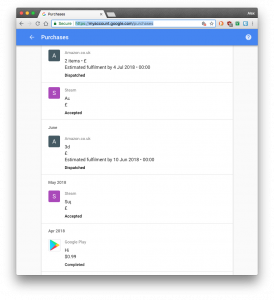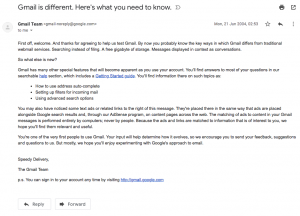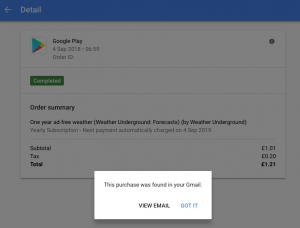I haven’t written much about privacy on this blog, despite often behaving, by some people’s standards, like a paranoid schizophrenic where my data is concerned. Until fairly recently I used to run a rooted phone with XPrivacy installed, which is about as private as you can get without ditching smartphones altogether. These days I’ve gone back to a stock un-rooted phone, partly because Android permissions have improved (although you do have to be careful with apps targeting older APIs), and partly because rooting is more risk and burden to me as a user. Also, some apps actively attempt to block rooted devices for quite legitimate (if, I would argue, misguided) reasons.
Anyway, I could go on for hours about Android privacy, but the subject of this post is Gmail. We all know that Google mines your personal data for targeted advertising purposes. But when giving data to companies, there’s a balance between functionality that is useful to you, and commercialising your data for purposes that, often, are not in your best interest.
While Gmail was once an innovative service, I’d argue that the scales have long been tipped in favour of commercialisation, and that today the data cost of Gmail outweighs its value as a service.
A brief history of Gmail
I’ve been a Gmail user since 2004, which is a little scary. And even before the launch, the purpose of Gmail was right there in the welcome email:
You may also have noticed some text ads or related links to the right of this message. They’re placed there in the same way that ads are placed alongside Google search results and, through our AdSense program, on content pages across the web. The matching of ads to content in your Gmail messages is performed entirely by computers; never by people. Because the ads and links are matched to information that is of interest to you, we hope you’ll find them relevant and useful.
From the start, Gmail’s raison d’être was literally to serve you ads.
In the early days of Gmail, the targeting was very basic; Gmail would serve you ads based on the message you were reading. For example, if you were having an email conversation about TVs, you might see Adsense ads from TV retailers in the sidebar. In a 2009 blog post, I documented this happening.
The method has changed though. While originally you were shown ads beside your emails, later on those ads were removed.
Why? Probably because Google realised that Gmail’s value was not in its display inventory, but the data that it gathers. Removing the ads made it more attractive to users, removing a reason for them to switch away, and thus made it more potent as a data gathering tool.
Oddly enough, contextual ads (that only target you based on whatever email you are currently reading), were deemed creepy by consumers. The targeting was very “in your face”, but also transparent. So, naturally, Gmail evolved to obscure this tracking from you.
Today, Gmail is simply an Email Client and data ingestion service, which doesn’t show you any ads. They even stopped scanning your messages for advertising purposes. This, I’ll argue, is of little consequence from a privacy perspective.
Why Google’s announcement of an end to Gmail ad-targeting was a little disingenuous basically bullshit
They still read your emails. The data just feeds into other services, such as “purchases” (requires a signed-in Google account):
I probably don’t need to explain this, but purchase history is a marketing gold mine. Just as the most likely weather for today is the same as yesterday, your past purchases inform your future ones. It is also highly personal and sensitive information, which you shouldn’t give up lightly!
And there is no way you could convince me that Google would not use a database of your purchasing history to inform the ads that it serves you around the web.
So, what possible use is Purchases to the user? I didn’t sign up for Google Purchases, and I have no need for a list of all my past purchases in one handy web view. As a stand-alone product, granting full read access to your email (aka electronic memory), just so you could see your purchases in a list, would be absurd.
Essentially, we’ve gone from “Gmail ➡ Adsense” to “Gmail ➡ Purchases ➡ Adsense“.
This doesn’t look like a meaningful distinction to me, and in reality, Purchases is probably just a web view into the a system that was already parsing your emails before the announcement.
But you can remove them, right?
Only if you delete the email. Clicking on a purchase and then on the tiny “i” icon in the top right shows you a menu with one item: “where is this from”, which informs you that the purchase was “found in your Gmail”.
Thus to remove the item from purchases, you have to remove the email from Gmail, and, maddeningly, this requires 6 clicks:
- Open item
- Tiny ℹ️ icon
- Where is this from
- View Email
- Load message in gmail
- Delete
Removing every Purchase in this way would take a very long time, and in any case I don’t think I should have to delete my emails to remove my data from an unrelated service, which, to me as a user, is utterly useless.
And it doesn’t stop at purchases.
Take a look at subscriptions and reservations. Both of these are also scraped from your email. Combined, these three categories of email probably represent the most valuable data that Google could gather from your email, because they represent past spending.
It’s time to ditch Gmail
Google’s announcement last year, that it ended the practice of reading your email for advertising purposes, is basically bullshit. When it comes to data mining, it’s like saying that they’re no longer removing rocks from the gold mine.
After 14 years of Gmail, last week I finally moved my email to Fastmail. I wish I had done it sooner. My experience, and review of Fastmail as a service, will be coming in a future blog post.



Bravo!
Pingback: Improving your privacy with a custom email domain | Al4